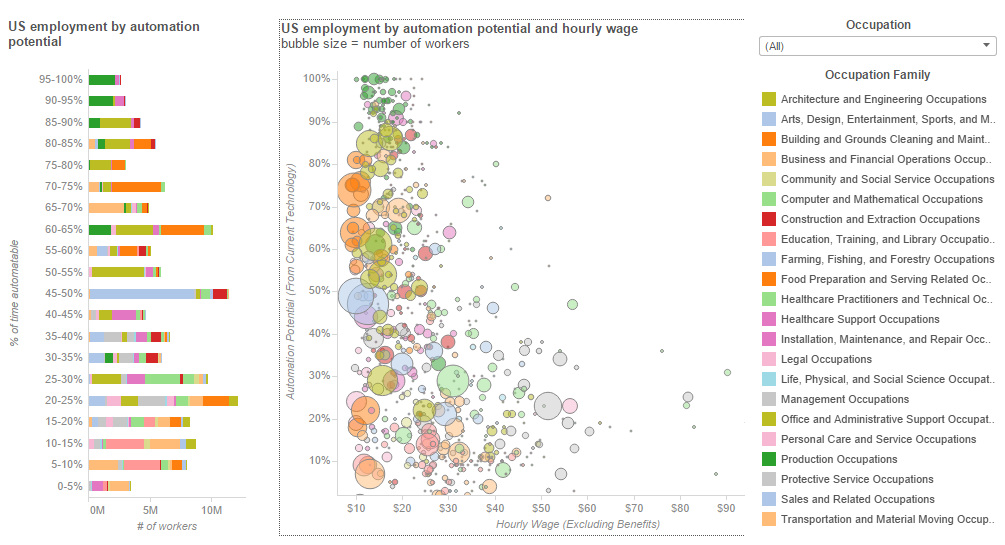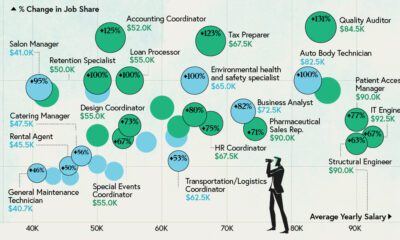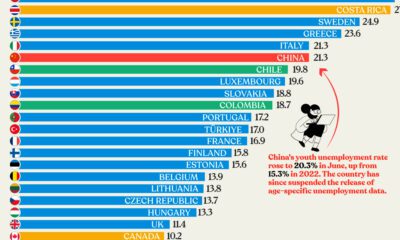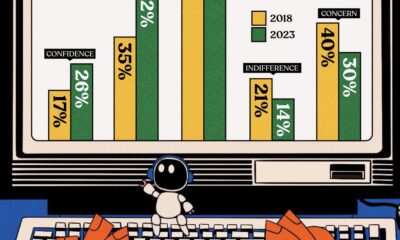Technology
Charting the Automation Potential of U.S. Jobs
Charting the Automation Potential of U.S. Jobs
In last week’s Chart of the Week, we noted that 1.3 million industrial robots would be installed between 2015 and 2018, and this would more than double the stock of active robots around the world.
While many of those robots will be used in the automotive and electronics sectors, there are many other roles that robots will be filling in the future. Surprisingly, according to global consultant McKinsey & Co, not all of these jobs are low-skill, low-wage jobs, either.
Mckinsey ran a comprehensive study of nearly 800 different jobs in the United States, ranging from CEOs to fast food workers. Between these roles, they found 2,000 individual work activities, and assessed them against 18 different capabilities that could potentially be automated. In their analysis, they found that 45% of work activities representing $2 trillion in wages can already by automated based on proven technology that currently exists. A further 13% of work activities in the U.S. economy could be automated if the technologies used to understand and process human language were brought up to the median human level of competence.
Who’s in, Who’s Out?
The interactive visualization above charts specific careers on their automation potential (out of 100%) along with the hourly average wage of the job.
What is most interesting about the analysis is that automation potential doesn’t correlate with low-skill, low-wage jobs as much as one may think. While it’s true that the three million fast food workers across the country have an automation potential of 74%, and that heavy truck driving activities can be 69% automated, there are also great counter-examples: for example, only 7% of manual labor and 22% of janitorial activities could be automated.
Likewise, high-paying jobs are not necessarily robot-proof.
Doctors (23%), nurses (29%), and even CEOs (25%) all have significant amounts of their jobs that can be automated with current technology. Almost half (47%) of what pharmacists do can be done by a robo-pharmacist, and 72% of commercial pilot activities can be done through computers.
Not interested in having a robot fill your shoes? Mckinsey notes at the end of their analysis that both creativity and sensing emotion are extremely difficult to automate. Focus on building skills and competencies in these categories, and you’ll be just fine (for now, at least).
Technology
All of the Grants Given by the U.S. CHIPS Act
Intel, TSMC, and more have received billions in subsidies from the U.S. CHIPS Act in 2024.

All of the Grants Given by the U.S. CHIPS Act
This was originally posted on our Voronoi app. Download the app for free on iOS or Android and discover incredible data-driven charts from a variety of trusted sources.
This visualization shows which companies are receiving grants from the U.S. CHIPS Act, as of April 25, 2024. The CHIPS Act is a federal statute signed into law by President Joe Biden that authorizes $280 billion in new funding to boost domestic research and manufacturing of semiconductors.
The grant amounts visualized in this graphic are intended to accelerate the production of semiconductor fabrication plants (fabs) across the United States.
Data and Company Highlights
The figures we used to create this graphic were collected from a variety of public news sources. The Semiconductor Industry Association (SIA) also maintains a tracker for CHIPS Act recipients, though at the time of writing it does not have the latest details for Micron.
| Company | Federal Grant Amount | Anticipated Investment From Company |
|---|---|---|
| 🇺🇸 Intel | $8,500,000,000 | $100,000,000,000 |
| 🇹🇼 TSMC | $6,600,000,000 | $65,000,000,000 |
| 🇰🇷 Samsung | $6,400,000,000 | $45,000,000,000 |
| 🇺🇸 Micron | $6,100,000,000 | $50,000,000,000 |
| 🇺🇸 GlobalFoundries | $1,500,000,000 | $12,000,000,000 |
| 🇺🇸 Microchip | $162,000,000 | N/A |
| 🇬🇧 BAE Systems | $35,000,000 | N/A |
BAE Systems was not included in the graphic due to size limitations
Intel’s Massive Plans
Intel is receiving the largest share of the pie, with $8.5 billion in grants (plus an additional $11 billion in government loans). This grant accounts for 22% of the CHIPS Act’s total subsidies for chip production.
From Intel’s side, the company is expected to invest $100 billion to construct new fabs in Arizona and Ohio, while modernizing and/or expanding existing fabs in Oregon and New Mexico. Intel could also claim another $25 billion in credits through the U.S. Treasury Department’s Investment Tax Credit.
TSMC Expands its U.S. Presence
TSMC, the world’s largest semiconductor foundry company, is receiving a hefty $6.6 billion to construct a new chip plant with three fabs in Arizona. The Taiwanese chipmaker is expected to invest $65 billion into the project.
The plant’s first fab will be up and running in the first half of 2025, leveraging 4 nm (nanometer) technology. According to TrendForce, the other fabs will produce chips on more advanced 3 nm and 2 nm processes.
The Latest Grant Goes to Micron
Micron, the only U.S.-based manufacturer of memory chips, is set to receive $6.1 billion in grants to support its plans of investing $50 billion through 2030. This investment will be used to construct new fabs in Idaho and New York.
-

 Technology6 days ago
Technology6 days agoAll of the Grants Given by the U.S. CHIPS Act
-

 Uranium2 weeks ago
Uranium2 weeks agoThe World’s Biggest Nuclear Energy Producers
-

 Education2 weeks ago
Education2 weeks agoHow Hard Is It to Get Into an Ivy League School?
-

 Debt2 weeks ago
Debt2 weeks agoHow Debt-to-GDP Ratios Have Changed Since 2000
-

 Sports2 weeks ago
Sports2 weeks agoThe Highest Earning Athletes in Seven Professional Sports
-

 Science2 weeks ago
Science2 weeks agoVisualizing the Average Lifespans of Mammals
-

 Brands1 week ago
Brands1 week agoHow Tech Logos Have Evolved Over Time
-

 Energy1 week ago
Energy1 week agoRanked: The Top 10 EV Battery Manufacturers in 2023
















